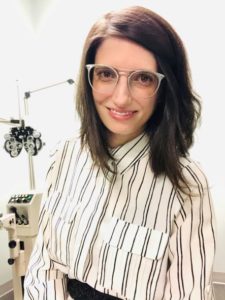

By Jennifer Lyerly, OD, TrueVision Eyecare, Raleigh, North Carolina
Presbyopia is more than just a visual condition; the effects can be emotional and personal. Not long ago, I was visited by Carol, a 57-year-old patient, for a routine eye exam. All her life she had excellent vision, but she was now experiencing changing near vision, changing distance vision, and eye dryness and discomfort. As eye doctors, we are prone to thinking those complaints at her age are run of the mill, but I could see she was nervous, wondering if she was going blind, or was seriously sick. I quickly reassured her that she was experiencing presbyopia and other “birthday-related” eye changes, and we spoke at length about the condition, what to expect, and how we could address it together. I listened to her concerns and helped ease her mind by explaining the relevant physiology in meaningful—but tactful!—ways while keeping my tone positive and reassuring. When she left, she knew that she was in good hands.
Conversations like these aren’t difficult, but they do require empathy and good “bedside manner.” Many patients with emerging presbyopia are unfamiliar with the condition and don’t know what’s happening; many others are uncomfortable talking about their own aging. Handled appropriately, emerging presbyopia is an opportunity to connect
personally with a patient, improving your relationship while providing with meaningful care.


My practice is very contact lens-oriented—my personal mindset for patient care is to ask every eligible patient if they’re interested in contact lenses. I also like to give patients a lot of information, to empower them to make informed choices about their own care. For patients like Carol, with presbyopia, I talk about both monovision and multifocal correction, but I actively try to steer them towards multifocal correction whenever appropriate because of the advantages of having both eyes working together for vision. I know that many practitioners are still hesitant to prescribe multifocal lenses,1 but they are my preference, since they allow both eyes to be involved in all visual activities. When I discuss this with patients and explain that driving with one eye, or reading with one eye isn’t as ideal as doing those activities with both, they understand right away the advantage of a multifocal contact lens over monovision options.
Because Carol had such great vision up until recently, she was new to needing corrective lenses. She wasn’t sure about so many things that my regular patients take for granted—for example, what spectacles might look good on her; and, how does insurance work? I had to start from scratch with her! She was also surprised to learn that she was a good
candidate for multifocal contact lenses, something she had never thought about before. She was interested in lenses that she could insert in the morning and forget about until nighttime, when she’d throw them away, before starting fresh the next day. She also revealed that she suffered from significant seasonal allergies. After trying a few options, we landed on DAILIES TOTAL1® multifocal contact lenses as the right option for her.
Carol thinks they are exceptionally comfortable2–4 and is having a great experience.
There are many ways that we optometrists can improve our patients’ lives. Every spectacle prescription, every health check, helps people. But there is a special satisfaction and joy that comes from empowering a person to take back their quality of life, as Carol did. It’s a gift for both doctor and patient. If you value those times that you can really touch a patient’s life to make it better, then fitting appropriate patients in multifocal contact
lenses is an invaluable way of achieving that goal.


References
1. Morgan PB, Woods CA, Tranoudis IG, et al. International contact lens prescribing in 2019. Contact Lens Spectrum. 2020;35:26-32.
2. Based on a survey of 544 presbyopic contact lens wearers. Alcon data on file, 2017.
3. Kern J, Kannarr S, Miller JD. Clinical outcomes for Dailies Total1 Multifocal lens in symptomatic patients. Presented at the British Contact Lens Association Clinical Conference & Exhibition, June 9-11, 2017. Liverpool, UK.
4. Pruitt J, Bauman E. The development of Dailies Total1 Water Gradient contact lenses. Contact Lens Spectrum. June 2013.
Sponsored by Alcon
See product instructions for complete wear, care and safety information.
© 2020 Alcon Inc. 9/20 US-DT1-PRA-2000002



